
In this section we explore the various disasters and other interesting weather phenomenon that Burra has been subjected to over the years. -
FLOOD

Ruins of Burra's Pig and Whistle bridge swept away in the 1890 flood

1909 Flood in Burra
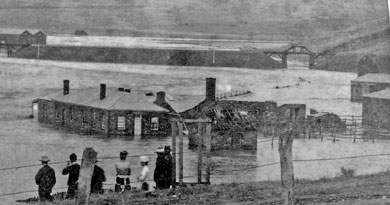
Aberdeen, Burra, in the April 1915 flood
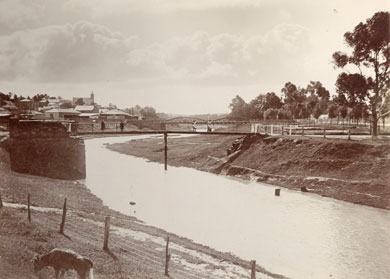
Bridge Street, Burra

"Alec Williams 21" - We believe this is Alec Williams in 1953, at the Young Street Ford at Burra North.

Burra's Whitehart flood
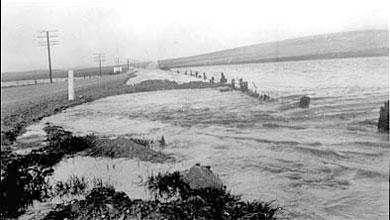
Flood, Burra, 13th September, 1960

1983 flood in Burra
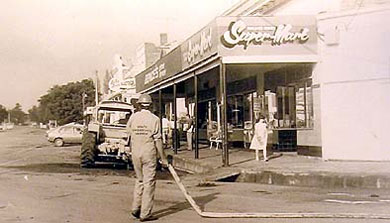
1983 flood in Burra
Floods. From our Kooringa correspondent:
The late heavy rains have caused an immense destruction of property among the huts excavated in the banks of the creek. Some months ago the Patent Copper Company made a roadway across the creek for the use of the carts carrying the ores from the mine to the smelting works. This roadway being raised several feet above the level of the creek formed a complete dam across the waterway, a very small channel being left for the water to flow through. On Thursday morning the creek assumed a very alarming appearance, and the channel through the roadway soon became choked. The water soon rose above the roofs of many of the huts, the inmates being glad to escape with their lives. Upwards of eighty huts were utterly destroyed, the furniture floating about in all directions. The water accumulated so quickly that in many instances large sums of money were forgotten to be removed. In one instance a man dived after his money, said to be upwards of £100, and succeeded in recovering it. It was a sad sight to see the women and children midst the heavy rain endeavouring to save their furniture from the flood which had destroyed their dwellings, and having no place to go for shelter. Many found shelter in the stables belonging to the “Smelters’ Home” public house, and in Messrs Thompson and Kekwick’s stores. The officers of the South Australian Mining Association rendered assistance to the unfortunate sufferers by sending carts belonging to the mine to assist in conveying such furniture as could be saved from the flood to a place of shelter, and as many families were admitted into the storehouses now being erected as could find room.
(Reproduced from the Northern Mail, 30 March,
1877
Page 1.159)
On March 19 there was some flooding caused by a thunderstorm and the weather failed to clear as it usually did and on each following day there was some rain until on Thursday 22 March it rained through the night becoming torrential on Friday from midday on.
Burra Creek burst its banks near the Unicorn Brewery and formed a second channel parallel to the main one. By 5:30pm it was level with the roadway in Bridge Street and then it broke through to form a channel between the bridge and the Bible Christian Church. Lower Thames Street was flooded as were most houses between Station & Henderson's [Market Square] and the Primitive Methodist Chapel. Fences and outbuildings between Thames Street and the creek were swept away. Houses on the western side of Paxton Square were flooded 6-9".
At 7.00pm the Bridge Street Bridge was swept away which allowed the water level to fall quickly by some 2-3'. The bridge structure remained fixed to the eastern buttress and both ended up about a mile downstream.
At Aberdeen there was a sheet of water from Opie's Hotel to the new railway embankment. And water 2-3' deep with a strong current was flowing up the road between the White Hart and the Aberdeen Hotels. Near Tiver's Corner it was 3' deep and the Aberdeen Hotel was flooded to several inches. This stream reentered the main creek between Orchards and the Burra Mill.
Ridgways store was flooded as were most houses between Tiver's Corner and the White Hart Ford. The Bank of Australasia was surrounded, but not flooded.
(Reproduced from the Burra Record, 7 Feb. 1890, Page 2-3)
7 Feb. 1890, page 2-3
Rain.
Heavy rain fell at 4.30 a.m. Wednesday in a thunderstorm that delivered 1½ in about 20 minutes with even heavier falls to the north. Between 8 and 9 a.m. the Burra Creek came down a banker and Mt Bryan Flat was under water for several miles. Low-lying areas of Redruth became a lake and many families were flooded out. The peak came between 10 and 11 a.m. The Temperance Hotel, occupied by Mrs Reed as well as the Redruth Eating House, lately occupied by Mr F.E. Bromley, the house occupied by Mt Thomas Hall and several others were completely swamped. The premises of J. Tiver and B. Preece were surrounded by water. In Kooringa much damage was done to roads and footbridges. The footbridges opposite the Post Office, behind the Burra Hotel, opposite the Bible Christian Church and near the old Pig and Whistle were all demolished. We have not heard of any personal injury.
(Reproduced from the Burra Record, 14 Apr. 1915, Page 2)
The Drought Breaks
The rainfall for 1914 was a total of 7.17". In the first three months of 1915 the drought continued with 0.33" in January, 0.02" on February and 0.14" in March.
Then from Easter Monday we were teased with 0.13" and 0.02" on Tuesday and 0.06" on Wednesday. On Thursday there was 0.30" to 3 p.m. after which it began to pour down. Premises were flooded and all the creeks were running bankers. The flood began to be compared with the great flood of 1874 and was generally reckoned bigger. About 1.70" fell in the day and by 9 a.m. the next day 1.95" had been recorded. The flood swept away footbridges at the Burra Hotel and at the Pig and Whistle. The Commercial Hotel cellar was filling up and water was pouring through S. Burns' shop, through Bagot, shakes and Lewis's Office and at E.J. Harris's they were fending it off with brooms. A number of private bridges also went and Mrs Howell had to be carried out of her cottage.
In Aberdeen there was a lake from the railway line to the Racecourse. W.B. Page took a great photo from the railway line near the Bon Accord Hotel, with Mr Robertson's house in the foreground and Drew & Crewes' bulk store surrounded and a great mass of swirling water under the Bon Accord Bridge.
Robertson's was quickly flooded. The two ladies took refuge on the window sill, feet dangling in the water, till swimming snakes made them turn around and close the window. When their predicament was noticed M-C Queale was sent for. Mr Shakes tried to get to them, but was almost swept away at the footbridge leading to the house. Mr McKeogh swam out to them. They were eventually reached from the Copperhouse side and rescued on horseback by M-C Queale, W. Field, C. Rabbich, F. Highett and Shakes. Damage to the house is estimated at £150.
Lionel Oppermann was caught trying to cross the White Hart ford by Gully's house when a sudden wave of water washed the horses round one post of the footbridge and the lorry round another. Oppermann tried to save the horses. He managed at considerable risk to cut the harness and both horses eventually clambered out of the water. The lorry ended up in the creek opposite Walker & Sons Aberdeen shop, where it was secured by ropes. The footbridge was soon after swept away.
About 15" of water invaded A. Thamm's.
Mrs Allen's house was also flooded with furniture floating in the rooms. [The old Bushman's Rest Hotel] Here it was high enough to run out of the windows, leaving cartloads of mud behind.
Drew And Crewes lost 7 cases of benzine, 3½ cases of kerosene and 1 of methylated spirits, along with fencing posts, strainers and the harness and lorry at the ford.
Sara & Co had their benzine magazine flooded and their chaff shed was 3' deep in water.
News from Mt Bryan and Hallett is scarce, but falls there were heavy. At Leighton falls were light only and at Baldina only 1.64" fell, but floodwaters came down the creek. Barker Bros lost 60 sheep and A.G. Gebhardt of Mackerode lost 40. At Hogback the flooding was severe and at King's Well the torrent was half a mile wide and 4' deep. Several miles of the Eastern Telephone line are washed away. Clearly much fencing has been lost. There are also further sheep losses.
Eastern rainfalls were very variable from as low as 0.35" at Glenora and 0.35" at Koomooloo to 1.64" at Baldina and 1.50" at Mongolata.
Here is an article
on the March 1983 flood, taken from The Burra Community News. The publication was
sponsored by the Apex Club of Burra and District and was simply a
photocopied A4 production, which filled the gap between the time the Burra
Record ceased and the Burra Broadcaster started.
(Reproduced from
the Burra School and Community News, 10th March 1983)
Flash Flood Inundates Burra
Last week tropical cyclones Ken and Elinore, which were situated over the Northwest and Northeast coasts of Australia respectively combined their efforts to feed into South Australia a moist unstable airstream which resulted in unseasonable tropical weather being experienced throughout the state.
During Wednesday afternoon and evening, accompanied by constant rumbling of thunder 38mm (1½ inches) of rain fell on Burra and some surrounding districts. During the afternoon one State Emergency Service crew was dispatched to Mt. Bryan to rescue two tractors that were bogged and soon to be submerged in what was, a few hours earlier, a dry and dusty dam. Another S.E.S. crew was sent to assist with flood relief in Clare but returned when required to help with the floods in Burra. At about 7.15p.m. the creek which flows through Kooringa broke its banks causing torrents of water to flow rapidly along Commercial and Thames Streets causing some flooding of business houses, but the hardest hit were the National Trust* cottages in Thames street, some of which had 30cms. Of water flowing through them at the peak of the flood. During the crisis sandbagging was swung into force by some S.E.S. members and volunteers whilst others blocked off roads and directed traffic around the worst affected areas.
Thursday morning saw the clean up operation of the streets and houses begin in earnest. A carpet, which had suffered severe damage had to be removed by S.E.S. members. The midday weather report, which predicted further storms to hit during mid afternoon put police and S.E.S. members on full alert and 250 sandbags were filled in readiness. At 3.00 p.m. a violent tropical thunderstorm unleashed 24mm (95 points) of rain and hail on Burra in 45 minutes. Flooding was extensive throughout Burra and at one stage 25 S.E.S. volunteers were working furiously protecting houses in Tregony Street, Burra North. During this operation two S.E.S. volunteers were swept down the water course suffering minor cuts and bruises.
At the peak of the storm, Police ordered that children were to remain at school until the danger had passed. School was dismissed 50n minutes later than normal. A 1000 gallon tank which had been picked up by floodwaters was smashed against the Ayres Street Bridge and reports of damage to roads including the new bitumenised road to the Redruth Gaol and the new bike track were received. Friday morning saw yet another storm, which hit at approximately 5.30 a.m. Twenty S.E.S. members and Police reported to the makeshift headquarters at the Council Office but only minor flooding, was experienced. On Saturday eight Burra S.E.S. members travelled to the Barossa Valley to assist in clean up operations in this very badly hit area.
Controller of the S.E.S. in Burra, Des James said that the townspeople had rallied together extremely well to combat the common crisis. Thirty-five townspeople registered with S.E.S. as volunteers giving valuable help to the fifteen S.E.S. members. The response from business houses with food and drink was excellent and much appreciated by the volunteers. The ladies of S.E.S. welfare were hard at work throughout the crisis preparing soup, food and hot and cold drinks.
Bags used during the food were loaned to S.E.S. by Collinsville, Adelaide and Wallaroo Fertilisers, Bruce Stockman and Angus McInnis. Thanks to Ivan Hirschausen for the use of s front-end loader and tarpaulins.
Any person who has any property of the S.E.S. ring D. James on 922290 or return to 3 East Street
* Note:- Although the paper stated that the cottages are owned by the National Trust, this was an error on their behalf. The cottages are heritage listed, but not owned by the National Trust.
Here is a collection of some of the outbreaks of fire that have occurred in Burra. We have reproduced their stories as told in the words of the local paper of the time.
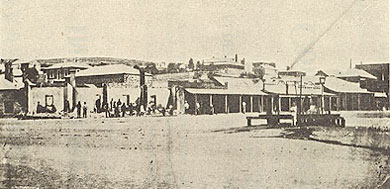
Market Square, Burra, after the Great Fire in 1883

Fire at S.M. Lane's Saddler and Ironmonger shop in Burra
Gaslight and the National Australia Bank can be seen at the right

Fire at S.M. Lane's Saddler and Ironmonger shop in Burra

Market Square, Burra, pre 1911, as it appeared before the 1915 fire

Market Square, Burra, in World War I - the ruins of the cottages which were burnt down in the 1915 fire can be seen in the background

Bakery fire in Burra
FIRE
(Reference:Burra Record, V. 237, 12 January 1883 , Page 2)
The Market Square Fire 1883
The most disastrous fire in Burra's history broke out on the morning of 6 January, 1883 when the continuous note of steam whistles roused the town. A fire was destroying four of the newest shops in Kooringa and threatening many others.
The fire underscored the need for a better water supply. Willing workers saved the surrounding buildings, but a reel would have helped greatly. Even better would have been a large supply of water fed by gravity as suggested recently by Dr Brummitt. A reservoir of 80,000 to 100,000 gallons on the hill would supply water for troughs, water carts, pipes to the larger houses and an abundant flow in case of fire. As the supply would only go to those who wanted it there would be a great advantage over a Government scheme where all would have to pay. Furthermore the profits would go to the town. We are glad that the Town Council took the matter up favourably at its last meeting. It now awaits a report from a competent engineer re costs and practicability. This should be a scheme for the whole town and not just one ward. Revenue then would also be the property of the whole town.
At least the purchase of a reel would not be very costly and would protect business premises.
The total loss from the fire is estimated at c. £4,000, almost all of which is covered by insurance. Nothing was saved from the four shops. Drew & Co.'s stores and other large shops on the other side were saved by willing work and the change and then drop in the wind.
(reference: Burra Record, Wednesday, March 10, 1915)
Fire in Burra
A Serious Conflagration 1915
The most serious conflagration which has occurred in Burra for a considerable number of years took place last week when the row of old stone buildings forming the south-eastern boundary of Market Square and belonging to Messrs Walker & Sons were completely gutted. About 11.30 on Tuesday, night, 2nd inst., the alarm was given by Mr. Harrap and although assistance was almost immediately forthcoming the flames had so great a hold that, without proper appliances it was impossible to check their advancement.
The fire evidently started in Mr. J. Allen's office. Mr. G. Lord, who was one of the first on the scene, almost had the fire under with a patent extinguisher but the machine became exhausted. The flames were practically subdued in the front room, but the back room continued to merrily blaze away. Mr. A. Walker then had a try with another extinguisher with similar success. Then the crowd got to work with buckets but the supply of water that could be pumped was insufficient to keep the buckets going and finally all efforts were directed to two objectives, viz. to save Pederson and Sons' boot shop at one end of the row and Harrap's pie shop at the other. Underneath the iron roof of the burning building right along the row was an old paling roof dry as tinder and once this started there was no stopping it burning without some appliances, a hydrant and hose, with very little exertion, would have confined the fire to the spot where it started. Fortunately Messrs Pederson and Sons had taken precautions in view of such an emergency. The fire was kept back from their roof by a high parapet wall, and they also had a 60ft. hose running from the water supply which, with the strenuous efforts of hosts of willing workers; was sufficient to keep the fire from doing more than some slight injury to the wall and scorching the verandah.
Adjacent to Mr. Allen's office on the other side the place was occupied by the owners, Messrs Walker and Sons. They had a considerable stock of crockery, tinware and linoleums, etc., in it which was practically all destroyed. Then came Mr. Harrap's private residence. There was no saving this so all the furniture was removed, fortunately with very slight damage, as there was no insurance on it. Across a 12ft. right-of-way was the pie shop.
Had it caught there would have been little chance of saving Mr. W. Truscott's butcher shop or the business place of Mr. E. J. Harris. However, with the aid of wet bags on the roof on which a small hose was kept playing, the fire was confined to the original row of buildings. Nothing but commendation can be expressed for the way the crowd worked. At Pederson and Sons' the toil was strenuous and to save the pie shop those who held the hose on the roof were subjected to the discomfort of dense clouds of smoke which were met without flinching. M.C. Queale was active in superintending operations. There were so many good assistants that it would be unfair to particularize.
The contents of Mr. Allen's office were insured for £30. I also contained the records and guernseys and other property of the Burra Football Club which were all completely destroyed. The buildings were insured for £500 and Messrs Walker and Son's stock for £300.
On Wednesday evening, as will be seen below in the evidence given at the inquiry, the fire started again at the rear of Mr. Harrap's old residence but was speedily got under. As is well known there have been several previous attempts at incendiarism in Burra during the last few months. At the rear of the same row on Sept. 27th a fire was started; on Oct 2nd, what looked like an attempt to burn down Mr. F. Harris's place was made; on Oct 25 a similar attempt was made in regard to Mr. A. D. McLaren's shop; on Nov, 29, a further attempt was made to burn down the buildings which were finally wiped out last Tuesday. In connection with the attempt on 29th Nov. It will be remembered that after the fire was extinguished outside and nearly everyone had gone home. Mr. L. Day noticed a second fire burning inside one of the rooms-------There is one thing that stands out prominently, and that is the absolute necessity that the Council should take immediate action regarding the formation of a Fire Brigade or at least that some appliances should be procured. If the fire had occurred amongst the business places on the other side of the street, with a favorable wind the damage would have been simply enormous. If the council funds will not stand the strain an appeal should be made to the town. As we all know, appeals are only too common just now but his is a mere business proposition. Everyone will surely contribute a quota to provide against fire and if all assist the contribution required from each individual would be small. Is there any other town in the State the size of Burra without a Brigade. We doubt it, and it is anyway just abut time that the town, for its own protection, was brought up-to-date in this particular. It a really big fire occurs in the future and the Council has done nothing but get prices for appliance their position will not be an enviable one.
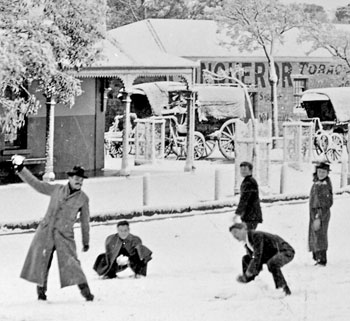

Snow
Snow has made an appearance over the years in Burra. The following is a summary from the Burra Record of the various times when snow has fallen:
1901
July 27. 'White Sunday' - Burra's greatest snowstorm.
(Reference: Burra SS Jubilee Year Souvenir Booklet 1951)
Burra had its biggest fall of snow in July 1901. Snow commenced to fall at 9 p.m. on Saturday, 27th July and continued all night and fell intermittently until mid-day on the Sunday, when the sun peeped through and the snow melted. Snow was three feet deep up against some of the buildings and walls and the whole country is described as having looked like a Christmas card.
In the meantime citizens went 'mad' snowballing each other and there must have been a regular skirmish in Market Square when 50 persons joined in the fight. Photographers were at work in all directions and some of these pictures are preserved to this day and make historical relics of interest. A local person deplores the actions of the locals on Burra White Sunday. He is reported to have chronicled that 'a prominent citizen allowed himself to be buried in snow upon a neighboring mountain' and that Sabbath decorum was at a discount, religious services were poorly attended and one of the collections was the smallest on record. But the highlight of the day was when some of our grandfathers collared one of the local policemen and gave him a thorough rolling in the snow.
1904
A mantle of snow covered Burra.
1905
Tuesday 29th August second heaviest fall to that date (after 1901) Snow fell 4-5 a.m. and 7-11a.m. and extended far to the north being particularly heavy at Mt. Bryan. Monday 4th September extensive falls from Petersburg (Peterborough) to Mt Bryan over previous tow days. None in Burra but on Monday visible on the hills just to the north of the town.
1908
Monday 22nd June, heavy snow in the early morning with thaw about 9 a.m. Persisted all day in sheltered places. Another heavy fall at 2 p.m. melted quickly.
Tuesday 30 June snow on the hills and record fall to that date at Mt. Bryan, Burra Creek froze over in the town sufficiently to support children.
1909
Sunday 25th July and Thursday 29th July saw light snow in Burra with a heavier fall on Sunday 1st August, which at Mt. Bryan persisted through Monday.
1910
Sunday 9th October. Snow in Burra which persisted all day on higher ground around Mt. Bryan and Hallett.
1917
Tuesday 21st August. Snow fell early in the morning and further falls in late morning. It melted by about noon but remained on the hills.
1919
Saturday 6th September produced driving hail, sleet and snow. Snow fell heavily around midnight with several inches on the ground on Sunday morning. More fell around midday and the views of the hills, especially around Mt. Bryan were magnificent. Rain removed it in the afternoon at Burra.

Market Square,Burra, during the 1901 Snow storm
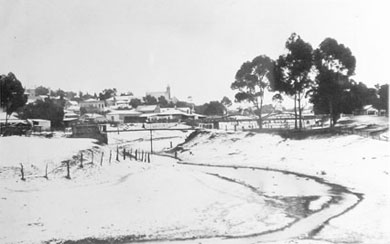
The result of the 1904 snow storm on Kooringa Bridge and Burra Creek
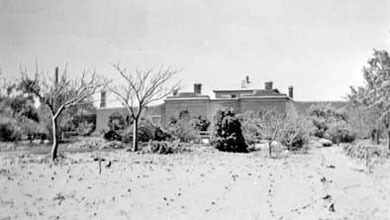
Snow at Redruth Jail, Burra, sometime between 1916 and 1922
1923
Sunday 30th September. Snow fell heavily about 3.30a.m. A.J. Cousin's funeral took 5 hours through snow, rain and hail to cover 20 miles from Booborowie to Kooringa. The horses often refused to move on in the blizzard conditions.
1926
May 10th Heavy fall of snow Peterborough, Hallett, Terowie and Mt. Bryan. Light fall at Burra at 3.30pm. Around Hallett it fell continuously for 6 hours.
1927
Snow fell in Burra on Saturday 24th September with falls before 6.30a.m. and again just after 7.a.m.
1929
30th August - 1st September, extreme wind and cold with sleet after severe dust storms.
Burra has suffered from both mice and rabbit plagues in her history.
Included below are some excerpts from Burra Record, which describe the plagues as they occured.
MICE
XV, 646, 5 Oct. 1904, page 4
Mouse numbers are high at present. The other afternoon a group of farmers' sons quickly bagged over 4,000 in the hills near town. Any bush is likely to have 20-30 under it. Young crops are being attacked and in places earlier in the season they consumed much seed so that some farmers had to sow a second time.
RABBITS
XV, 654, 30 Nov. 1904, page 4
Rabbits. Never have they been so numerous as now. They can be seen in their thousands and in places there are heaps of dead rabbits piled up from weakness and poison. For miles along the eastern road the stench is almost unbearable. They are seen in droves towards Ketchowla and even in the town some fences have been the site for 100 to 300 to be killed in an hour or so.
XV, 657, 21 Dec. 1904, page 4
Rabbits continue in plague proportions, though being actively slaughtered. Mr J. Pick of Braemar has been taking up to 3,376 in a single night and has disposed of between 15,000 and 16,000 recently.